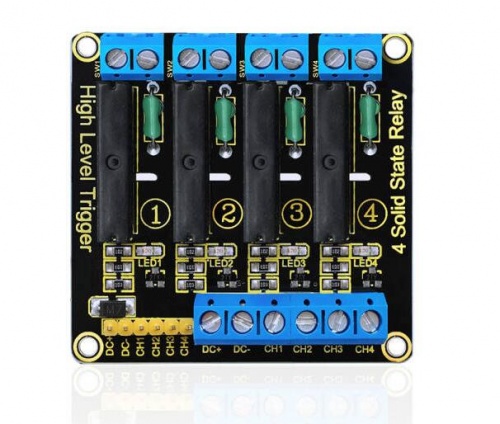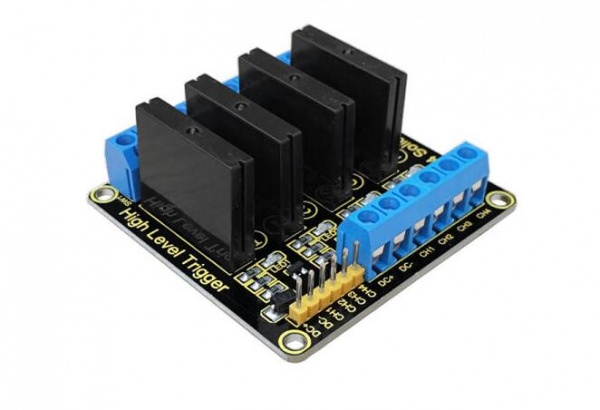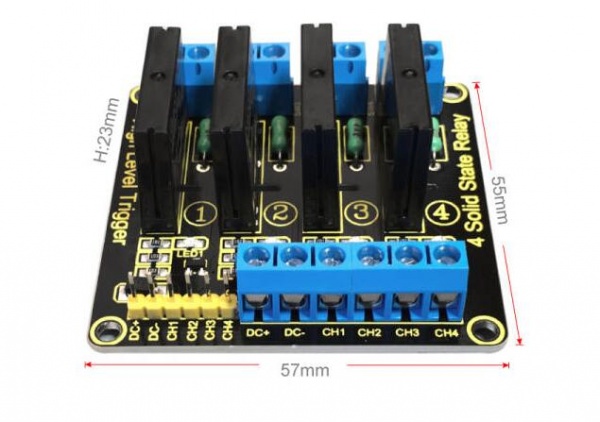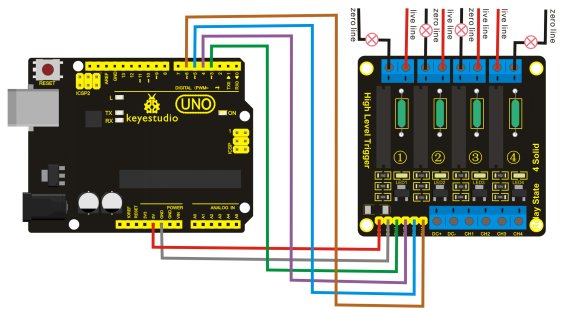Ks0265 keyestudio Four-channel Solid State Relay Module
Keyestudio Four-channel Solid State Relay Module
Introduction
Keyestudio four-channel solid state relay is active at HIGH level, that is to say, the input control signal is the low level (0-2.5 V), the relay is off; while the input control signal is high level (3.3-5 V), the relay is on.
Solid State Relay is a new kind of contactless switching device, which is composed of all solid state electronic components.
Compared with the electromagnetic relay, it has higher reliability, with the features of non-contact, long service life, fast speed and less outside interference.
The output control terminal of keyestudio solid-state relay must be connected to the circuit, can only be AC (Alternating Current) ,so that the solid state relay can be disconnected normally.
Performance Parameters
- Electrical parameters:
| Voltage | Static Current | Working Current | Trigger Voltage | Trigger Current | |
|---|---|---|---|---|---|
| Channel 1 | DC 5V | 0mA | 12.5mA | 3.3-5V | 2mA |
| Channel 2 | DC 5V | 0mA | 12.5mA | 3.3-5V | 2mA |
| Channel 3 | DC 5V | 0mA | 12.5mA | 3.3-5V | 2mA |
| Channel 4 | DC 5V | 0mA | 12.5mA | 3.3-5V | 2mA |
- Output port: AC240V/2A
Connection Diagram
Sample Code
int BASE = 3 ; //The first relay I/O port
int NUM = 4; //Total number of relay
void setup()
{
for (int i = BASE; i < BASE + NUM; i ++)
{
pinMode(i, OUTPUT); //Set the digital I/O port to output
}
}
void loop()
{
for (int i = BASE; i < BASE + NUM; i ++)
{
digitalWrite(i, HIGH); //Set the digital I/O port outputs to "HIGH", that is, gradually open
delay(200); //delay
}
for (int i = BASE; i < BASE + NUM; i ++)
{
digitalWrite(i, LOW); //Set the digital I/O port outputs to "LOW", that is, gradually close relay
delay(200); //delay
}
}
Result
Wiring as the above image,after powered-on,four-channel solid state relay is first connected and then broken successively,repeating alternately.
Resource
- PDF:
https://drive.google.com/open?id=1hUkCtLh-d_HAmRfkDVpZllZHrEsjiNX-
- Code:
https://drive.google.com/open?id=1fOlgG-K_BotBfaFJH12MrFI2AM6M3oFM
- VIDEO:
http://video.keyestudio.com/ks0265/



